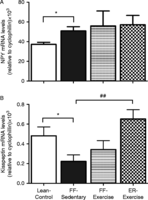Cardiometabolic and reproductive benefits of early dietary energy restriction and voluntary exercise in an obese PCOS-prone rodent model
- Abdoulaye Diane1,
- Maria Kupreeva1,
- Faye Borthwick1,
- Spencer D Proctor1,
- W David Pierce2 and
- Donna F Vine1⇑
- 1Metabolic and Cardiovascular Diseases Laboratory, Alberta Institute of Human Nutrition, Alberta Diabetes Institute
2Department of Sociology, University of Alberta, Edmonton, AB, Canada
- Correspondence should be addressed to D F Vine; Email: donna.vine{at}ualberta.ca
-
Figure 1
Body weight gain (A), energy intake (B), percent fat mass (C) and percent lean body mass (D) in the JCR:LA-cp obese PCOS-prone rodent model following dietary energy restriction and exercise intervention (n=6 rats/group). Data are shown as mean±s.e.m., **P<0.01 Lean-Control compared to FF-Sedentary; #P<0.05 FF-Sedentary compared to ER-Exercise. FF, free feeding; ER, energy restricted.
-
Figure 3
The postprandial response in plasma glucose (A), insulin (B) and insulin/glucose ratio (C) following a meal tolerance test the JCR:LA-cp obese PCOS-prone rodent model following dietary and exercise intervention (n=6 rats/group). Data are shown as mean±s.e.m. *P<0.05 Lean-Control compared to FF-Sedentary; #P<0.05 FF-Sedentary compared to ER-Exercise.
-
Figure 4
Estrous cyclicity in the JCR:LA-cp obese PCOS-prone rodent model following dietary and exercise intervention (n=6 rats/group). Data are shown as mean±s.e.m. *P<0.05 Lean-Control compared to FF-Sedentary; #P<0.05 FF-Sedentary compared to ER-Exercise. FF, free feeding; ER, energy restricted. Estrous cyclicity was assessed by vaginal cytology for each rat for 21 consecutive days at the end of the intervention, days 60–81.
-
Figure 5
Hypothalamic arcuate nucleus mRNA expression of neuropeptides (A) NPY and (B) Kisspeptin in the JCR:LA-cp obese PCOS-prone rodent model following dietary and exercise intervention (n=6 rats/group). Data are shown as mean±s.e.m., *P<0.05 indicates a genotype effect (Lean-Control compared to FF-Sedentary), ##P<0.05 FF-Sedentary vs ER-Exercise. Target gene expression was normalized to a reference gene (cycophilin). NPY, neuropeptide Y; Kiss, kisspeptin.
-
Figure 6
Hypothalamic arcuate nucleus mRNA expression of neuropeptides (A) CART, (B) Mc3r, (C) POMC and (D) Mc4r in the JCR:LA-cp obese PCOS-prone rodent model following dietary and exercise intervention (n=6 rats/group). Data are shown as mean±s.e.m., *P<0.05 indicates a genotype effect (Lean-Control compared to FF-Sedentary), #P<0.05 FF-Sedentary vs ER-Exercise. Target gene expression was normalized to a reference gene (cycophilin). CART, Cocaine and amphetamine regulated transcript; Mc3r, melanocortin receptor 3; Mc4r, melanocortin receptor 4; POMC, proopiomelanocortin. FF, free feeding; ER, energy restricted.
- © 2015 Society for Endocrinology

















